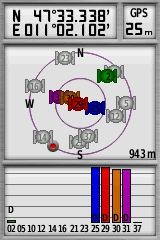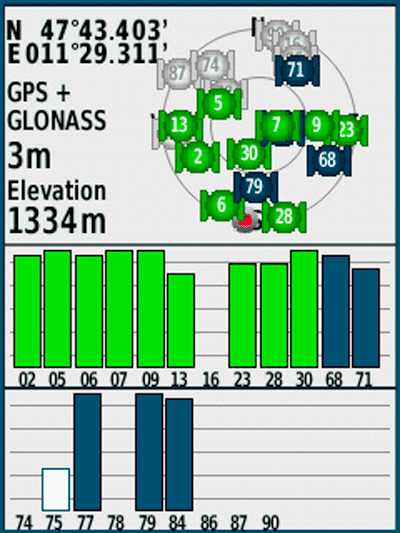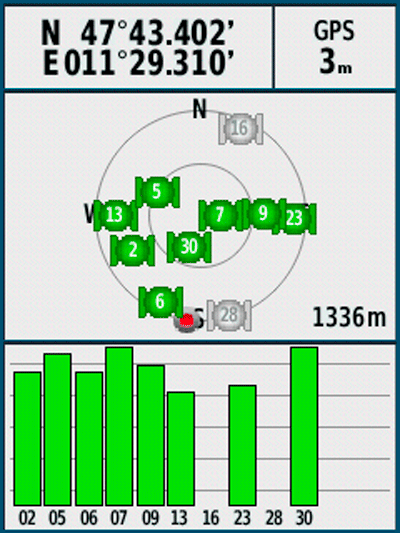The use of two satellite systems is now the standard for many current outdoor handhelds, bicycle devices and wearables from Garmin. GPS & GLONASS is usually already activated in the device settings. Alternatively, you can switch to GPS & GALILEO or GPS only.
Many current Garmin devices allow these GNSS* combinations:
- GPS
- GPS + GLONASS (currently the Garmin standard)
- GPS + GALILEO
Positioning with the help of two GNSS has its advantages. The availability of two systems means that more satellites are available. This can have an impact on the time to first positioning (TTFF = time to first fix) and the positioning accuracy.
*GNSS = Global Navigation Satellite System
How many GPS, GLONASS & GALILEO satellites are available?
(status: July 2022)
- GPS: 31 operational satellites
- GLONASS: 22 operational satellites
- GALILEO: 22 operational satellites
Information on the current statuses can be found here:
- www.gps.gov (GPS)
- www.navcen.uscg.gov (GPS)
- www.glonass-iac.ru (GLONASS)
- www.gsc-europa.eu (GALILEO)
Check the live positions: in-the-sky.org or gnssplanning.com.
What are the advantages of using two GNSS like GPS, GLONASS or GALILEO simultaneously?
A good example is shown in the figure. Due to the availability of only four GPS satellites and an unfavourable satellite geometry in a NW – SE running mountain valley (three out of four GPS satellites are in a row), the position determination is relatively inaccurate. The accuracy is shown as "25 m".
The same applies to large cities. High buildings ("urban canyons") can also cause shadows effects, there are fewer satellites in the direct field of view of the GPS receiver.
In addition, "multipathing" effects often occur in mountains and cities, caused by walls, snow, facades of buildings & road surface. Reflected satellite signals also result in poorer accuracy.

What positive effect has a second GNSS?
More satellites distributed over the sky can lead to a more favourable distribution ("geometry") and thus to a better accuracy and a faster positioning (TTFF).
Garmin defines GPS accuracy as follows:
Accuracy of the position in m (CEP, Circular Error Probable: 50% of all measurements are within the specified radius (e.g. 25 m), 50% of all measurements are outside of this radius).
Another note: At least three satellites are required to determine the position, and at least four satellites must be in use to determine the GPS altitude.
What are the disadvantages of using GPS, GLONASS and GALILEO simultaneously?
The disadvantage is the slightly increased power consumption of the GPS receivers, in my experience it is about 10% (GPS handhelds like Garmin Oregon or eTrex). The situation is likely to be similar for bike computers and wearables.
Garmin – GPS only, GPS & GLONASS or GPS & GALILEO – What do you recommend?
This is a generally difficult topic, as many factors play a role: chip manufacturer, firmware, algorithms, GPS antenna type, antenna placement, energy consumption of the GPS receiver and antenna, available energy, mounting of the device, environment, …
Outdoor handhelds
Figures (screenshots Garmin eTrex 32x):
Excellent satellite reception; GPS + GLONASS (left) does not lead to a better accuracy compared to GPS only. The accuracy is always 3 m. GPS: 02 – 30, GLONASS: 68 – 84.


To be prepared for all eventualities I recommend two GNSS and to change to "GPS only" only when the battery consumption plays a role!
GPS + GLONASS or GPS + GALILEO
Since GPS + GLONASS is standard with Garmin, I would prefer this combination. The devices are possibly optimized in this respect. In practice, however, I have – based on the analysis of track recordings – not yet seen any real differences.
Important is the current satellite constellation at the respective position … and that can be sometimes good or sometimes less good … that’s why I would commit to a system and not switch back and forth.
Edge cycling devices
Since the devices are attached to the handlebars, signal shadows can occur through the rider’s body. So I would recommend to use GPS + GLONASS, except you want to save battery.
Wearables
The situation is different for wearables.
For example, when you run, the wearable is attached to a second dynamic system: your moving arm. The GPS antenna usually points somehow to the side and not skywards, your body causes shadowing when receiving satellite signals. All these factors can lead to GPS inaccuracies.
Therefore, it is better to get the maximum out of it by using GPS + GLONASS – this setting is also the Garmin standard for wearables and is continuosly optimized.
What GNSS technology trends can be expected in 2022 and beyond?
There are now handheld devices with chips that support not only simultaneous reception of multiple GNSS ("multi-GNSS"), but also of multiple frequencies ("multi-band"). Examples are the GPSMAP 65s and the GPSMAP 66sr (review), launched in 2020. These devices can provide a faster TTFF and a better accuracy. However, my experience shows that no miracles should be expected – standard GPSMAP devices are already very good in terms of accuracy (in my opinion the helix antenna plays a big role).
Garmin might have initiated another development with the new GPSMAP 79s handheld (launched late 2021). The GPSMAP 79s does not provide multi-band. But it is equipped with multi-GNSS for simultaneous reception of GPS, GLONASS, Galileo, QZSS and BeiDou satellites. In my opinion, this will become the standard for future Garmin handhelds.
Edge bike computers are now also undergoing a change. The 2022 Edge 1040 models come with Multi-GNSS & Multiband: As expected, this leads to very accurate and consistent records.
The development is similar for multisport watches. With the fenix 7 and epix 2, Garmin has also introduced GNSS chips* that ensure maximum precision. Other models include the Forerunner 255 and Forerunner 955.
*as already mentioned, other factors besides the GNSS chips play a role!
The new generations of handheld devices, bike computers and multisport watches allow the following settings (differences are only in the choice of words):
Example: GPSMAP 66sr
- GPS only
- Multi-GNSS
- Multi-GNSS + Multi-Band
Example: fenix 7X
- GPS only
- All systems
- All + Multi-Band
Example: Edge 1040
- GPS
- Multi-GNSS
- Multi-GNSS Multi-band
Meanwhile, the fenix 7 or the epix 2 offers another special feature with the "AutoSelect" option. The function known as SatIQ ("satellite intelligence") automatically selects the best setting. Battery consumption is optimized, users no longer have to worry about anything!
I bought a Garmin Forerunner 245 because my Forerunner 225 battery is getting old. I’ve used both on each arm and the accuracy is very different. My old watch was very accurate. If I run 10 km, I am now a minute faster. My new watch gives 0.5 to 1.5% more distance. I use GPS+Galileo. I will now try GPS+Glonass. I hope I get a better result, because it also gives the wrong speeds to run.
Old watch using galileo or glonass?
I don’t know, can’t choose like the 245.
Joachim,
Thank you for this excellant website – I have learned a lot by simply reading your articles and the comments.
Very happy owner of an Etrex 30x and 64s – recently got 2m accuracy showing on the Etrex – the new GP3 satellites helping maybe ?
Thanks
Craig W
Do GPS, GLONASS and Galileo cover southern Africa? I operate mainly in the South Africa bush and like the garmin fenix 6x to use as a GPS.
Hi Angus,
GPS, GLONASS, Galileo, BeiDou are global, you can check the actual constellation here:
https://in-the-sky.org/satmap_radar.php?year=2021&month=12&day=8
https://www.gnssplanning.com/#/maps
You can use an app for phone, like https://play.google.com/store/apps/details?id=com.chartcross.gpstest&hl=en_US&gl=US
Dear Frieds,
I bought a Garmin Forerunners 245 befor 2 months. I tried GPS, GPS+Glonass and GPS+Galileo also. All of which measured bu a great failure. i.e GPS+Galileo measured my 12 km of run as 24 km in 1 h 8 min as if I were a olimpic runners:) GPS+Glonass measure my 5 km run in 14 min that is not also possible and when I checked the mape, the route was quite differ that I runned. Later I tried only GPS but the result was not differ. It was a great disaappontment for me because my old watch "tom tom runner" that it much more cheaper was better in measurement. I used it for 4 years and with a great accuracy.
Could be please advice that what was wrong in my application? I run in forest area but formerly I runned many times mw to tom woth without problem. Please let me inform about adjusment ofmy watch for to get a good accuracy.
levent.ballice@ege.edu.tr
Best regards,
Ballice
Hello Ballice,
that sounds very strange; I have never seen or heard of such great deviations (12 km vs. 24 km)!
Did you install the latest update and did you connect the Forerunner with the Garmin Connect App (for an automatic update of the EPO file, this data enables the GPS chip to predict where satellites will be in the sky)?
You can also try a factory reset of the device.
May be your device is defect (can you give it back?).
Best regards
Great article 👌🏻👌🏻👌🏻
It would be even better (at the end of reading 😅) to get a Linkedin share option 🙏🏻
But as I said, it’s excellent!
Thank’s – the Linkedin button ist now added (floating bar on the left)
GLONASS is a Russian sat system , and they crash there cars all time 🙂
GALILEO an EU sat
Today a ran trail run in hills and forrest with Gamin Fenix 6 with GPS+Galileo and was less accurate than my second device Apple Watch 5. Garmin measured 11.04km and Apple Watch 11.94km. When i imported my activity to the Strava and Runkeeper and corrected the distance, both apps measured 11.98km, so very close to the Apple Watch. Before this run a had GPS + GLONASS as default in Garmin and last runs was almost equal with Apple Watch. (I wear two device on workouts, daily and sport). So i think GPS + Galileo for me is less accurate, but i will do some more test for final result in my case and my locations 🙂
Ben yeni aldığım forerunner 45S kullanıyorum. 2 gün arka arkaya aynı güzergahta (12km) yaklaşık 50m lik aynı hataları yaptı. hatalar gerçeğinden 50m eksikti (11,95km). Saat GPS+GLONASS modundaydı. Bana göre kabul edilebilir hatalardı. hataların tek yönde ve yaklaşık aynı değerde olmasını şimdilik standart hata olarak değerlendiriyorum.
Daha sonra aynı mesafeyi GPS+GALILEO modunda deneyeceğim.
My Garmin watch VivoActive4 works best with GPS + Galileo.
With GPS only or with GPS + Glonass I always have problems receiving satellite signals at all, even out in the open field.
Often I have to walk – run – cycle 6 kilometers or more before the VivoActive senses GPS + Glonass
With GPS + Galileo a brief 40 seconds max wait will do to get going.
Conecta el Vivoactive al Garmin Connect del teléfono para que se sincronicen. Con esto el telefono le pasa al reloj un mapa actual de los satelites que está actualizado y accesible por Internet. Verás que con esto tendrás el reloj conectado a GPS en pocos segudos, con cual quier combinación de GPS, o GPS + Glonass o GPS + Galileo.
I have a garmin 945 watch. Until now I used polar vantage and I had no problems with gps.
When registering a known route with a garmin watch, I was surprised that it is shorter than usually recorded with various watches or telephones, and the "actual tempo" indicator always shows a much lower pace than I actually run.
I did various tests for several weeks and I have such observations.
– In Europe (Poland) the GPS + Galileo configuration works best on a garmin watch
.
– GPS + Glonass works best on Polar
.
– When I set gps + glonass on my garmin watch, the accuracy of measurements decreases drastically.
– When I run with two watches, the distance is the same on both only when set (gps + glonass on polar) and (gps + galileo on garmin)
.
I wonder if one of these watches has a naming error and if by chance in a garmin watch gps + galileo mode is not really glonass.
Do you know how to check this?
Changing the registration from "smart" to "every seconds" did not improve the measurement accuracy very much.
What do you think about it, what are your opinions?
Hi Michael,
I do not believe that the Garmin wearables have a naming error – however, I do not know how to check which satellite systems are in use as the Garmin wearables have no NMEA output (except the quatix) or a satellite page.
My standard for the fenix is GPS + GLONASS as I want to compare it with other devices like the Polar GRIT X (Polar recommends GPS + GLONASS as default and has no option for "GPS only"), and I think it is generally better to use a wearable with two GNSS.
The data recording has no impact on GPS accuracy, because you change only the algorithm for recording and not the GPS frequency.
Cheers!
Hi, i úsed fenix 5+, testing in Hanoi, Vietnam. Gps only, gps + glonass , and gps + galileo , it is cloudy and raining condition. Result of gps +galileo showing more accurate than the others. Cheers
My Garmin 1000 doesn’t stay "fixed" on map mode, even when I push on the map + to expand. Any idea on how to correct this? It’s aggravating when I am out in the middle of the woods and trying to figure the road to take…(I care a paper map of the areas that I travel)
Hi,
what do you say? Does the position of the position marker changes continuously (can be a normal behaviour depending on the GPS signals)) or is the map moving even if stationary (sounds strange)?
Cheers